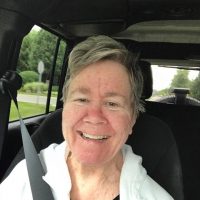
Double Your Impact for the Holidays
Double Your Impact for the Holidays
Your urgently needed year-end gift can go twice as far to provide care and support and accelerate Alzheimer's research this holiday season — and all year long. Show your giving spirit today during this 2x Match Challenge.
Donate Now Difficulty understanding new technologies at work. Lack of focus while driving. Forgetting to pay bills.
Difficulty understanding new technologies at work. Lack of focus while driving. Forgetting to pay bills.Flash back roughly 10 years, when Joey Daley began to notice irregularities in his mother’s behavior. She ended up having to quit her job, and things only went downhill from there.
She was in and out of doctors’ offices; some doctors would say her behavior was the effects of medication, but others would say it was depression. Dementia was never even brought up as a possibility until three years ago, when she was finally diagnosed with dementia with Lewy bodies.
After her diagnosis, the pursuit was on. The pursuit to raise awareness about dementia and Alzheimer’s disease. The pursuit to corral government funding. The pursuit for a son, the 45-year-old caregiver, to ensure his mom, the 67-year-old woman living with dementia, continued to experience some of life’s favorite offerings so often taken for granted. Things like grabbing a chocolate milkshake, taking a trip to the racetrack or enjoying a home-cooked meal in the company of family.
For the past five months, Joey Daley has been documenting his and his mother’s journey with dementia in a twice-weekly video series and started a movement – “Molly’s Movement.”

To date, Joey has posted 47 video episodes, but Episode #6 – the first day Molly ever failed to recognize her only son, followed by Joey’s heart-wrenching, on-camera breakdown – caught the world’s attention. That episode alone has been viewed over 2.2 million times. Collectively, the series of videos has been watched over 80 million times, having gone viral in more than a dozen countries. Recently, Joey chronicled his and Molly’s painstaking journey with us.
What an inspiring yet monumental undertaking. Do you have a team that helps you do all the behind-the-scenes work?
No, I don’t. To be honest, things are starting to get exhausting. Here I am with a video series that documents my mother’s slow descent into dementia. At the same time, I’ve created a support group that I feel very responsible for.
I created this movement, have a business, a family, everyday life. My mindset has always been: When you do things, go full-force. I’ve always thought I was unstoppable. I’m not going to quit, but it can be difficult. My ultimate goal is to help secure a steady flow of government funding for research, because that’s what I think it’s going to take, and that’s what’s going to keep me going.
Talk about your journey together, mother and son.
Some people think I just started picking her up and hanging out, but what I’m doing now (publicly with the video series) is exactly what we were doing before I started the movement. I’d pick her up to go out to eat, watch horse races, bring her to visit my house – some kind of activity that she enjoys. Then one day I asked her, “Would you want to do a video series and help other people understand more about dementia?” And her exact words were, “Well, yeah, if it’s going to help people!”
When she said that, I said, “Let’s do it.” I grabbed my GoPro camera and just started recording our time together.
You’ve posted 47 videos to date. How often do you try to produce a new one? I release a new video every Thursday and Saturday. I don’t know if I’ll ever slow down from that schedule; it really depends on my mom’s condition. I’m not an expert on dementia and I never tell people that I am, so maybe they can learn what not to do with the video series; that was the whole goal – to create awareness in a different way and be honest and open about how dementia impacts both those who live with it and their caregivers.
What triggered you to launch “Molly’s Movement?” The group (of video-series followers) moved me towards it. I had had people reach out to me wanting to get involved in the production, but I didn’t want the project to move away from what I had envisioned. I wanted my mother to have her own movement and for us to do things to give back the way I thought my mom would – and that’s giving back to caregivers. It just kind of evolved into everything it is today.
What was your reaction to the enormous response the videos generated?
After it went viral, I knew it would mean I would be on the phone non-stop talking to reporters and radio stations and anyone else interested in the story. It’s bittersweet. I’m excited that my mother is not going to die in vain, yet she’s still dying. It’s hard to get excited.
Why did you make it your personal mission to advocate for the cause vs. throwing your support behind another movement like so many have with yours?
I wanted to do what I felt was best for my mother and how she would have done things if she was in my position. She’s always given back in different, unique ways. It is unbelievable to me how she talks about her friends; even in her current situation grappling with this disease, she is still always thinking about the well-being of others. She even worries about what will happen to me when she dies. That is just the person she is – and I want to honor that.
{^youtubevideo|(width)425|(height)264|(rel)True|(url)https://www.youtube.com/watch?v=nt8C-P8Fc4g|(fs)True|(autoplay)False^}
Learn More:
